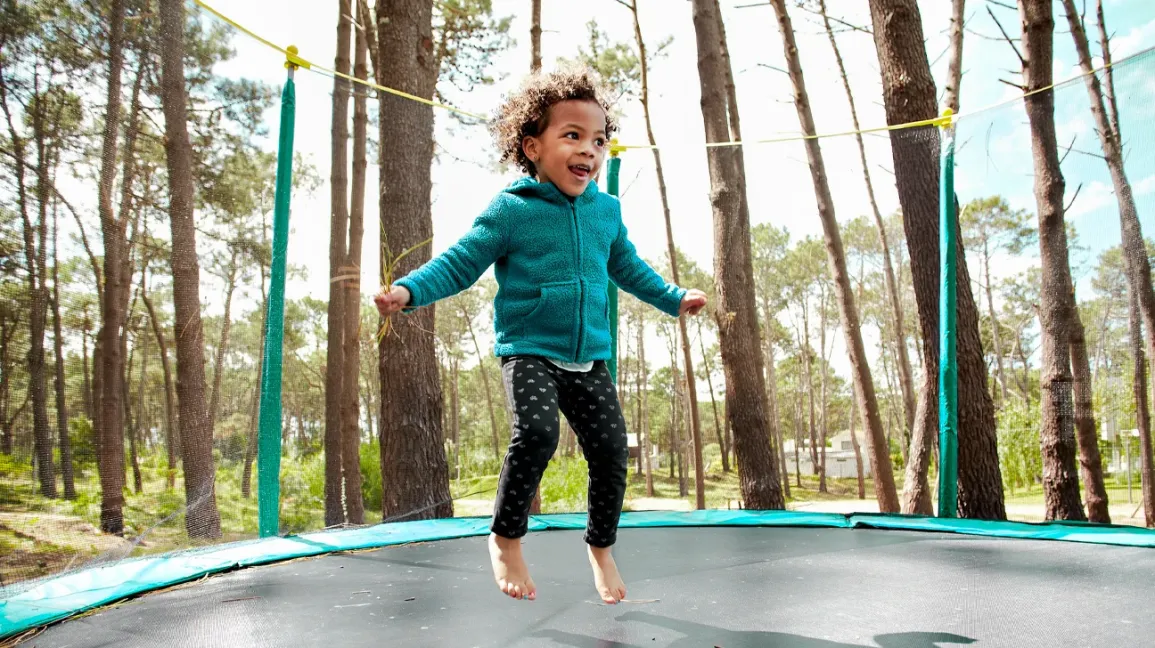Trampolines offer boundless fun for children, providing them with a thrilling way to expend energy and enjoy outdoor playtime. However, amidst the excitement, trampolines also pose risks for injury if proper safety precautions are not taken.
As parents, it’s crucial to find the delicate balance between allowing our children to enjoy the bouncing while ensuring their safety. In this comprehensive guide, we’ll delve into essential tips and strategies to help parents navigate trampoline safety effectively.
Understanding the Risks
Before exploring safety measures, it’s essential to comprehend the potential risks associated with trampoline use. Most injuries occur due to falls, collisions with other jumpers, or improper landings.
Understanding these risks underscores the importance of implementing stringent safety guidelines. An NCBI article states that most trampoline injuries in the US were treated in the emergency department. Thankfully, only 3.3% of these injuries resulted in a hospital stay.
This shows that the chances of injuries are very low. However, if any severe injuries occur, it can be devastating for the child and the parents. This can be especially true when the injury occurred due to technical faults in the product.
For instance, injuries can be sustained from a new product’s spring failure, frame damage, or worn mats. These injuries can also occur at trampoline parks due to management’s fault. Suppose the management didn’t replace an old mat. It can lead to injuries in children who use it for having fun.
In such situations, regulations are in place to compensate you for your child’s injuries. For instance, the Illinois General Assembly has laid down Sec. 2-14 for such scenarios. This section legally mandates that no person shall operate a trampoline court without liability insurance.
The liability insurance policy or policies should be no less than $1,000,000 for bodily injury. Any operator applying for a permit or renewal of an amusement park license must submit proof of this insurance.
Thus, suppose you went to a trampoline park in Edwardsville, Illinois, and your child was injured due to management’s negligence. In that case, you can hire an Edwardsville personal injury lawyer and file a lawsuit.
According to TorHoerman Law, an attorney can help gather evidence to strengthen your case. He or she will also assess damages to make an appropriate claim covering all your losses. Lastly, the lawyer can also determine liability, which is the basic foundation for compensation claims.
Now that you know the common risks, let’s look at how you can make trampoline jumping safe for your children.
Tips to Ensure Trampoline Safety
Trampolines can be a lot of fun, but they also have inherent risks. Here are some tips to ensure trampoline safety:
Selecting a Safe Trampoline
The first step in ensuring trampoline safety is choosing the right equipment. Opt for models with safety features such as enclosure nets, padded springs, and sturdy frames when purchasing a trampoline.
Verify that the trampoline meets safety standards established by organizations such as ASTM International or the International Organization for Standardization (ISO). Additionally, consider the size and location of the trampoline. It should be placed on level ground away from obstacles such as trees, fences, or hard surfaces.
Establishing Ground Rules
Setting clear rules and guidelines for trampoline use is paramount to ensure a safe jumping environment. Communicate these rules to your children and reinforce them consistently. Some essential rules may include:
- Only one jumper at a time: Multiple jumpers increase the risk of collisions and accidents. Consider the example of the little Leeland Korman. According to WPSD Local, this 8-year-old boy sustained brain injuries on a trampoline in February 2023. He was jumping with his sister, and their heads collided. He was kept in a medically induced coma. However, he got better within a week and survived to tell the tale.
- No somersaults or flips: These maneuvers pose a high risk of neck and spinal injuries.
- Bouncing in the center: Encourage children to jump in the middle of the trampoline, away from the edges where they are more likely to fall.
- Supervised jumping: Ensure that an adult is present to supervise trampoline activities at all times.
- No jumping under the influence: Discourage children from using the trampoline while under the influence of alcohol or drugs, as impaired judgment increases the likelihood of accidents.
Implementing Safety Gear
Establishing rules and guidelines and equipping children with appropriate safety gear enhances trampoline safety. According to the American Academy of Pediatrics (AAP), common trampoline-related injuries include fractures, sprains, bruises, and head injuries. Their study shows that 11% of injured people sustain significant injuries.
Based on these common problems, you can ask your children to wear appropriate safety gear. Encourage them to wear athletic shoes with non-slip soles while jumping to provide traction and stability. Additionally, consider outfitting them with protective gear such as knee pads, elbow pads, and helmets, especially for younger or less experienced jumpers.
Regular Maintenance and Inspection
Routine maintenance and trampoline inspection are essential to promptly identify potential hazards or defects. Inspect the trampoline’s frame, springs, and padding regularly for signs of wear, tear, or damage.
Tighten any loose bolts or fasteners and replace worn-out components promptly. Keep the trampoline clean and debris-free, as foreign objects on the jumping surface can cause slips and falls.
If you can’t handle the maintenance and inspection yourself, taking your children to trampoline parks is best. They have maintenance staff who constantly inspect for damages.
There are many such parks available across the USA. Illinois is about to see new parks being built by Altitude Trampoline Park. A PR Newswire press release shows that the company has started 2024 by signing nine deals to open new parks in different states. These parks will be built and opened in Illinois, North Carolina, South Carolina, and Tennessee.
Frequently Asked Questions
How Can I Make My Kids Trampoline Safer?
Making your kids’ trampoline safer involves several measures. Firstly, ensure the trampoline is set up on a level surface with appropriate padding around the edges to cushion any falls. Regularly inspect the trampoline for wear and tear, and promptly repair or replace any damaged parts.
What Are the Most Common Trampoline Injuries in Kids?
Kids’ most common trampoline injuries include sprains, strains, fractures, and bruises. These injuries often occur when children collide with each other while jumping, land incorrectly on the trampoline surface, or fall off the trampoline altogether. Head and neck injuries are particularly concerning and can result from landing on the trampoline frame or attempting risky maneuvers.
At What Age Are Trampolines Safe?
There isn’t a specific age at which trampolines become safe for children. However, most experts recommend against allowing children younger than six years old to use trampolines due to their underdeveloped coordination and balance skills. Even older children should be closely supervised while using the trampoline and taught proper jumping techniques to minimize the risk of injury.
To conclude, trampolines offer an exhilarating outlet for children to engage in active play and physical exercise. However, ensuring trampoline safety requires proactive measures and diligent supervision from parents and caregivers.
By following the tips in this article, parents can create a safe and enjoyable trampoline experience for their children. Ultimately, by striking the right balance between fun and risk, parents can help their children reap the benefits of trampoline play.


